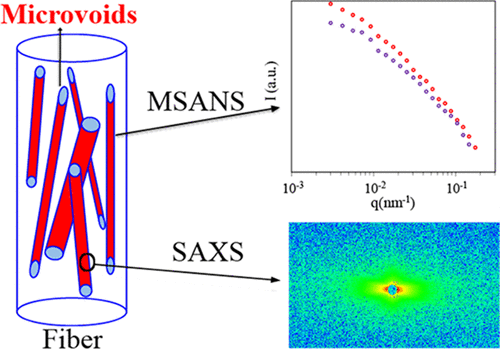当前位置:
X-MOL 学术
›
Macromolecules
›
论文详情
Our official English website, www.x-mol.net, welcomes your
feedback! (Note: you will need to create a separate account there.)
Characterizing Microvoids in Regenerated Cellulose Fibers Obtained from Viscose and Lyocell Processes
Macromolecules ( IF 5.1 ) Pub Date : 2019-05-30 00:00:00 , DOI: 10.1021/acs.macromol.9b00487 Aakash Sharma 1, 2 , Debasis Sen 3, 4 , Shirish Thakre 5 , Guruswamy Kumaraswamy 1, 2
Macromolecules ( IF 5.1 ) Pub Date : 2019-05-30 00:00:00 , DOI: 10.1021/acs.macromol.9b00487 Aakash Sharma 1, 2 , Debasis Sen 3, 4 , Shirish Thakre 5 , Guruswamy Kumaraswamy 1, 2
Affiliation

|
Regenerated cellulose fibers are among the most widely used bio-derived materials. Currently, there is great interest in transitioning from the traditional viscose process to the more environmentally friendly lyocell process for fiber production. Differences between the characteristics of viscose and lyocell fibers can be attributed to microstructural differences that arise due to differences in the processing techniques. Here, we use small-angle scattering to characterize the microvoids in regenerated cellulose fibers that might govern the onset of mechanical failure in these. In regenerated cellulose fibers, scattering of X-rays or neutrons at small angles is largely dominated by scattering from microvoids. We demonstrate that small-angle X-ray scattering (SAXS) over the q range that is typical for most commercial instruments arises from Porod scattering from the microvoid surfaces, viz., the scattered intensity scales as q–4. Therefore, it is not possible to extrapolate this data to lower q to obtain microvoid dimensions and volume fraction. We combine SAXS with medium-resolution small-angle neutron scattering to characterize the microvoids in regenerated cellulose fibers. Specifically, we compare fibers produced using the viscose process with those from the lyocell process. For both viscose and lyocell fibers, microvoids have a high aspect ratio and are elongated in the fiber direction. Also, the volume fraction occupied by the microvoids is comparable for viscose and lyocell fibers (0.04–0.05%). However, there are differences in the microvoid size: Microvoids are more highly oriented in lyocell fibers and have a larger average length and diameter compared with viscose fibers. This result might have important implications for understanding failure of these fibers.
中文翻译:

表征从粘胶和莱赛尔过程中获得的再生纤维素纤维中的微孔。
再生纤维素纤维是使用最广泛的生物来源材料之一。当前,对于从传统的粘胶工艺过渡到更环保的用于纤维生产的莱赛尔(Lyocell)工艺非常感兴趣。粘胶纤维和莱赛尔纤维的特性之间的差异可以归因于由于加工技术的差异而产生的微观结构差异。在这里,我们使用小角度散射来表征再生纤维素纤维中的微孔,这可能会控制其中的机械故障的发生。在再生纤维素纤维中,X射线或中子在小角度的散射主要由微孔的散射所主导。我们证明了q上的小角X射线散射(SAXS)对于大多数商用仪器而言,典型的范围是由微孔表面的Porod散射引起的,即,散射强度的标度为q –4。因此,不可能将该数据外推到较低的q获得微孔尺寸和体积分数。我们将SAXS与中等分辨率小角中子散射结合起来,以表征再生纤维素纤维中的微孔。具体来说,我们将使用粘胶工艺生产的纤维与来自莱赛尔工艺的纤维进行了比较。对于粘胶纤维和莱赛尔纤维,微孔的纵横比都很高,并且在纤维方向上是细长的。同样,微孔所占的体积分数与粘胶纤维和莱赛尔纤维相当(0.04-0.05%)。但是,微孔尺寸存在差异:与粘胶纤维相比,微孔在莱赛尔纤维中的取向更高,平均长度和直径也更大。该结果对于理解这些纤维的失效可能具有重要的意义。
更新日期:2019-05-30
中文翻译:

表征从粘胶和莱赛尔过程中获得的再生纤维素纤维中的微孔。
再生纤维素纤维是使用最广泛的生物来源材料之一。当前,对于从传统的粘胶工艺过渡到更环保的用于纤维生产的莱赛尔(Lyocell)工艺非常感兴趣。粘胶纤维和莱赛尔纤维的特性之间的差异可以归因于由于加工技术的差异而产生的微观结构差异。在这里,我们使用小角度散射来表征再生纤维素纤维中的微孔,这可能会控制其中的机械故障的发生。在再生纤维素纤维中,X射线或中子在小角度的散射主要由微孔的散射所主导。我们证明了q上的小角X射线散射(SAXS)对于大多数商用仪器而言,典型的范围是由微孔表面的Porod散射引起的,即,散射强度的标度为q –4。因此,不可能将该数据外推到较低的q获得微孔尺寸和体积分数。我们将SAXS与中等分辨率小角中子散射结合起来,以表征再生纤维素纤维中的微孔。具体来说,我们将使用粘胶工艺生产的纤维与来自莱赛尔工艺的纤维进行了比较。对于粘胶纤维和莱赛尔纤维,微孔的纵横比都很高,并且在纤维方向上是细长的。同样,微孔所占的体积分数与粘胶纤维和莱赛尔纤维相当(0.04-0.05%)。但是,微孔尺寸存在差异:与粘胶纤维相比,微孔在莱赛尔纤维中的取向更高,平均长度和直径也更大。该结果对于理解这些纤维的失效可能具有重要的意义。






























 京公网安备 11010802027423号
京公网安备 11010802027423号